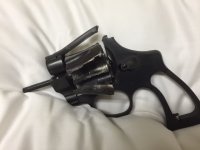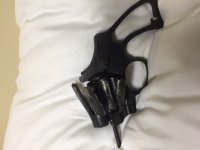Me first.
8.8 gr Bullseye in .45ACP
A quarter past double charge!
Yep, I did it.
Loaded up some 200gr LSWC with 3.8gr Bullseye Sunday morning. Went to the range. When I touched the first one off, the grips grabbed my palm like a ******* file. What th' . . . ? I put a glove on, and fired a couple more. Just as bad. I knew something was wrong. I closed up the box of reloads and pulled out an older box with 4.7gr of Bullseye. It was noticeably milder, and I had loaded the 3.8 because the 4.7 was too hot.
Back home, the investigation took 30 seconds. First thing I did was look at my scale, an RCBS 5-0-2 balance beam. The 0-4.9 selector was on 3.8. The 5 block was NOT on zero, it was on 5. So I didn't load 3.8, I loaded 8.8 !!!!!
I checked, I still have all my fingers! Gun seems to be okay.
What happened? It was my first production with my new Dillon 550B. When I do single stage loading, I use an RCBS Uniflow type powder dropper. It has calibrations on the adjuster, and I have records of every load I've made for many years. The Dillon powder dropper has no calibrations. You adjust and weigh, adjust and weigh. I'd like to see calibrations on the Dillon, but their design doesn't lend itself to calibration. But calibration wouldn't have saved me, because this was the first time I used it, and would have had no data to compare it to.
I had moved the scale from one bench to another. I assume I bumped the 5 block, and just didn't notice it had moved.
The other thing that got me is that with the progressive, you don't see the powder in the case. Loading single stage, all the cases with powder are examined. A double charge would be noticed.
I'll be more careful to check and double check the settings on my scale before loading, knowing what can happen. I say I'm lucky that no damage was done.
8.8 gr Bullseye in .45ACP
A quarter past double charge!
Yep, I did it.
Loaded up some 200gr LSWC with 3.8gr Bullseye Sunday morning. Went to the range. When I touched the first one off, the grips grabbed my palm like a ******* file. What th' . . . ? I put a glove on, and fired a couple more. Just as bad. I knew something was wrong. I closed up the box of reloads and pulled out an older box with 4.7gr of Bullseye. It was noticeably milder, and I had loaded the 3.8 because the 4.7 was too hot.
Back home, the investigation took 30 seconds. First thing I did was look at my scale, an RCBS 5-0-2 balance beam. The 0-4.9 selector was on 3.8. The 5 block was NOT on zero, it was on 5. So I didn't load 3.8, I loaded 8.8 !!!!!
I checked, I still have all my fingers! Gun seems to be okay.
What happened? It was my first production with my new Dillon 550B. When I do single stage loading, I use an RCBS Uniflow type powder dropper. It has calibrations on the adjuster, and I have records of every load I've made for many years. The Dillon powder dropper has no calibrations. You adjust and weigh, adjust and weigh. I'd like to see calibrations on the Dillon, but their design doesn't lend itself to calibration. But calibration wouldn't have saved me, because this was the first time I used it, and would have had no data to compare it to.
I had moved the scale from one bench to another. I assume I bumped the 5 block, and just didn't notice it had moved.
The other thing that got me is that with the progressive, you don't see the powder in the case. Loading single stage, all the cases with powder are examined. A double charge would be noticed.
I'll be more careful to check and double check the settings on my scale before loading, knowing what can happen. I say I'm lucky that no damage was done.


